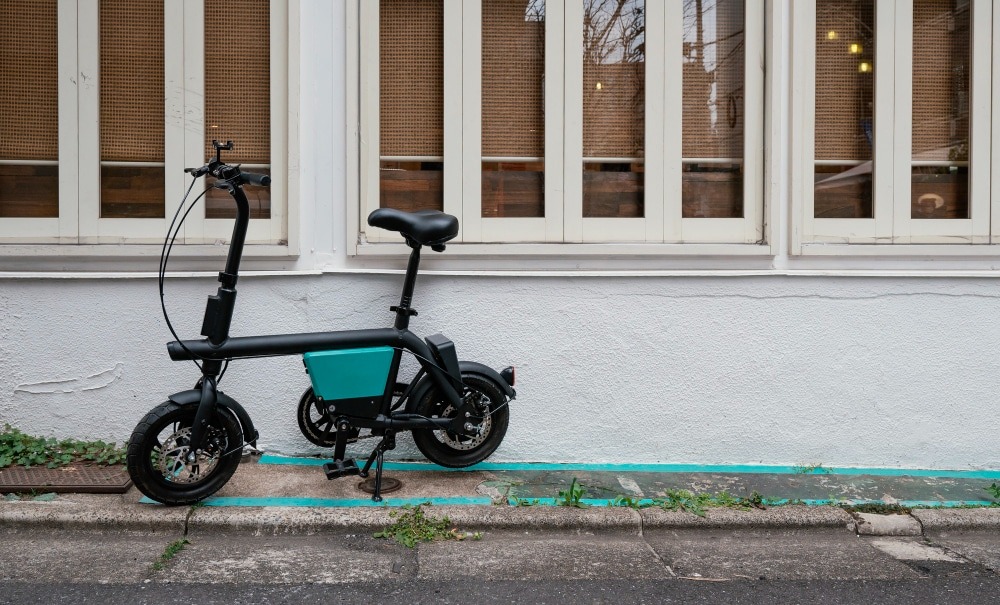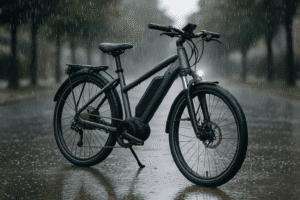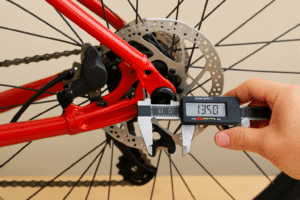If you’re wondering do you need a license for an electric bike, the answer depends on where you live and what type of e-bike you ride.
Most states don’t require a license for Class 1 and 2 e-bikes, but Class 3 models may come with extra rules like licensing, registration, or age limits.
TL;DR:
- Most riders don’t need a license to ride an electric bike in the U.S., especially for Class 1 and Class 2 models.
- Class 3 e-bikes, which go up to 28 mph, often face more restrictions, and some states may require a license, registration, or insurance.
- States like Alabama, Alaska, Hawaii, Massachusetts, and New Mexico require a license for certain e-bikes or riders.
- Always check your state DMV or local laws, since rules can vary by city or county.
- To avoid fines or confusion, make sure your e-bike stays within legal speed and power limits.
Do You Need a License to Ride an Electric Bike?
In most U.S. states, you don’t need a license to ride an electric bike, especially if you’re using a Class 1 or Class 2 model that stays under 20 mph. These bikes are usually treated the same as regular bicycles.
However, some states have stricter rules. If you live in Alabama, Alaska, Hawaii, Massachusetts, or New Mexico, you may need a valid license, especially for faster Class 3 e-bikes. These states may also require registration or have minimum age limits.
Since e-bike laws can change, always check with your state’s DMV before hitting the road. Riding legally means fewer headaches—and more time enjoying the ride.
States That Require a License for E-Bikes
If you’re in a state like Alabama, Alaska, Hawaii, Massachusetts, or New Mexico, you may need a valid driver’s license to ride legally. Age and registration rules may also apply depending on the class of your e-bike.
Here’s a breakdown of states that currently require a license:
| State | License Needed? | Description |
|---|---|---|
| Alabama | Yes | Driver’s license required for all e-bikes. Treated like mopeds. |
| Alaska | Yes | E-bikes classified as motor-driven cycles. Class M license required. |
| Massachusetts | Yes for Class 3 | License and registration required for Class 3 e-bikes. |
| Hawaii | Yes | Must be 18+ to register; license also required for riders. |
| New Mexico | Yes | Valid driver’s license needed to operate any e-bike. |
States That Do Not Require a License for E-Bikes
States like California, Florida, Utah, Virginia, and Washington make it easy to ride without needing a license or registration. However, age or helmet rules may still apply depending on the bike class.
Here are some examples of states that don’t require a license:
| State | License Needed? | Description |
|---|---|---|
| California | No | No license for Class 1 and 2; riders must be 16+ for Class 3. |
| Florida | No | No license or registration needed for any e-bike class. |
| Utah | No | No license or registration rules for e-bikes. |
| Virginia | No | No license required. Riders must be 14+ for Class 3 e-bikes. |
| Washington | No | No license or registration needed for any e-bike class. |
Notes:
- Even in states where no license is required, some local areas may have restrictions. Always check with your city or county.
- Class 3 e-bikes often have stricter rules—some states limit where they can be ridden.
Understanding E-Bike Laws: Federal vs. State Regulations
Electric bike laws can be confusing. The federal government has its own definition, but states make the real rules on licensing, registration, and where you can ride.
Federal E-Bike Regulations
Federally, e-bikes are defined as low-speed electric bicycles if they meet these conditions:
- Motor Power: 750 watts (1 horsepower) or less.
- Pedal Assist: Must have working pedals.
- Speed Limit: Motor assistance cuts off at 20 mph.
The Consumer Product Safety Commission (CPSC) regulates e-bikes as bicycles if they have operable pedals, meaning no federal license or registration is needed. But here’s the catch: federal law only applies to manufacturing and product safety. States set the rules for where and how you ride.
State E-Bike Regulations
Each state decides how to classify and regulate e-bikes. Some follow a three-class system, while others lump e-bikes with mopeds or motorized vehicles. That means:
- Some states require a license for certain e-bike types.
- Others treat e-bikes like traditional bikes, meaning no license is needed for most models.
- A few require registration, insurance, or specific safety gear like helmets.
Before you ride, check your local Department of Motor Vehicles (DMV) to avoid fines, legal issues, or riding in unauthorized areas.
Read more:
The Three-Class E-Bike System and Licensing Implications

Most states now follow the three-tiered classification system, which helps separate low-speed e-bikes from faster models that may come with licensing rules.
Class 1 E-Bikes
Class 1 e-bikes are the most like traditional bicycles. They only provide motor assistance when you pedal and stop helping at 20 mph.
Most states do not require a license for Class 1 e-bikes, and they’re often allowed on bike paths, trails, and roads—though some states may have age restrictions for certain classes. These are great for commuting or recreational rides without worrying about extra paperwork.
Class 2 E-Bikes
Class 2 e-bikes also have a 20 mph speed limit, but they come with a throttle that lets you ride without pedaling.
Many states don’t require a license for Class 2 e-bikes, but some have local restrictions, especially in parks or multi-use trails. If you love cruising without pedaling, check your local laws to see where you can ride.
Class 3 E-Bikes
Class 3 e-bikes are the fastest in the system, offering pedal-assist up to a maximum speed of 28 miles per hour. No throttle is allowed, but that extra speed makes them popular for commuters.
Because they go faster, Class 3 e-bikes often come with more rules:
- Some states require a license.
- Helmet laws apply in many areas.
- Restricted from bike paths in some states.
If you’re riding a Class 3, expect a few more hoops to jump through compared to slower e-bikes.
How to Know if Your E-Bike Needs a License
You might need a license if your e-bike goes faster than 20–28 mph, has a motor over 750 watts, or is classified as a moped or motor-driven cycle in your state.
In most states, Class 1 and Class 2 e-bikes are treated like bicycles, which means no license is required. But Class 3 models, especially those with higher speeds or throttles, may be subject to stricter laws.
Some states, like Alabama or New Jersey, require a license for certain e-bikes or riders. Always check your local DMV rules to be safe.
How to Get a License for Your E-Bike (If Required)
If your state has license requirements for electric bikes, the process usually mirrors that of getting a motorcycle or moped license.E-bike laws are constantly changing as more riders hit the road and cities adjust their rules.
Here’s what you’ll need to do:
- Check your state’s DMV website for specific e-bike licensing requirements.
- Gather your documents—this may include proof of identity, residency, and any required training certificates.
- Take a written test on traffic laws and e-bike regulations, if your state requires it.
- Pass a vision test to confirm you can safely operate a vehicle.
- Pay the license fee (costs vary by state).
- Receive your e-bike license—some states may issue a special license or add an endorsement to your existing one.
If your state also requires registration or insurance, you’ll need to handle that separately.
Additional Electric Bike Regulations to Consider
Beyond licensing, electric bike riders should be aware of other important rules to stay safe and legal on the road:
- Helmet Laws: Some states require helmets for Class 3 e-bikes or riders under a certain age. For example, California mandates helmets for all Class 3 riders.
- Where You Can Ride: While e-bikes are legal in most bike lanes and roads, cities ban e-bikes from trails or sidewalks, setting legal limits on where they can be used. Always check local laws before riding.
- Speed Limits: Class 3 e-bikes have a top speed of 28 mph, but some states cap e-bike speeds at 20 mph in certain areas.
- Night Riding: Many states require front lights and rear reflectors for night riding. Some cities may even have stricter visibility rules.
Even if no license is required, following your state’s legal requirements for e-bikes can help you avoid fines and ride with peace of mind.
Conclusion
So, do you need a license for an electric bike? For most riders, the answer is no. If you’re riding a Class 1 or Class 2 e-bike, you’re usually good to go without a license in most states. Class 3 e-bikes, however, face more restrictions, and a few states require a license, registration, or even insurance.
Since laws can change, it’s always smart to check with your local DMV before riding. Some cities and parks have their own rules, and the last thing you want is a fine when you’re just out for a ride.
Whether you need a license or not, staying safe and respecting the rules will help keep e-bikes a great, hassle-free way to get around.
FAQs
Do I need a license to ride an electric bike in the U.S.?
In most states, no. Class 1 and Class 2 e-bikes are usually treated like regular bicycles. But if you live in Alaska, Hawaii, New Mexico, or New Jersey, you may need a license, especially for faster models.
Which states require a driver’s license for electric bikes?
States like Alabama, Alaska, Hawaii, Massachusetts (Class 3), and New Mexico require a license to ride an e-bike. In most other states, only faster Class 3 bikes face restrictions.
Do I need to register my e-bike like a car?
Usually not. Most states do not require e-bike registration. However, places like Hawaii, Alaska, and some cities in New York may ask you to register depending on your e-bike class.
Are helmets required for e-bike riders?
Helmet laws vary by state. Class 3 e-bike riders often need a helmet, and some states require helmets for riders under 18. California and New York have strict helmet laws for e-bikes.
Can I ride my e-bike on sidewalks or bike paths?
It depends on local laws. Class 1 and 2 e-bikes are usually allowed on bike paths, but Class 3 e-bikes are sometimes restricted to roads. Some cities ban e-bikes on sidewalks entirely.
Michael Josh is a hands-on e-bike tester and reviewer at BoltBikers, known for putting every model through real-world rides before sharing his thoughts. With a sharp eye for performance, comfort, and build quality, he helps the team choose which bikes are worth featuring. Backed by years of experience in tech and gear reviews, Michael brings trusted, honest insights to help readers find the right e-bike for their needs.








